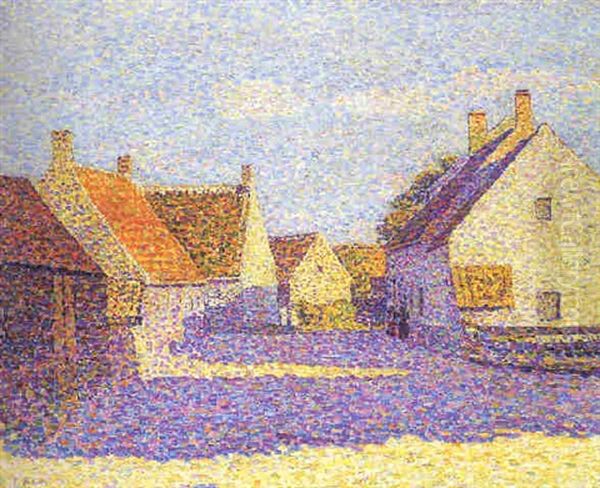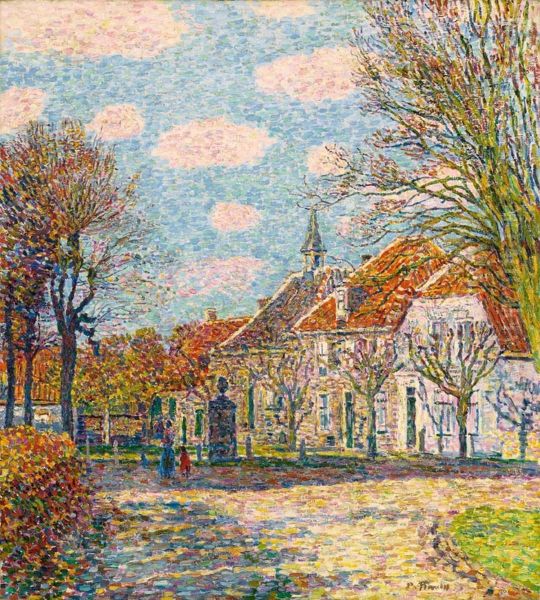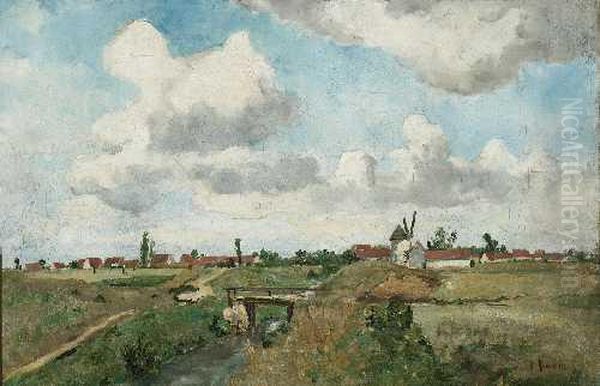
Paul Baum stands as a significant yet sometimes overlooked figure in German art history, particularly noted for his role in introducing and adapting French Neo-Impressionist techniques to a German context. Born in Meissen, Saxony, in 1859, and passing away in San Gimignano, Italy, in 1932, Baum's artistic journey spanned a crucial period of transition in European art. He evolved from the more traditional approaches of the Barbizon School to become one of Germany's foremost exponents of Pointillism, leaving behind a legacy of luminous landscapes characterized by meticulous technique and a sensitive handling of light and color.
Early Life and Artistic Formation
Paul Baum's artistic path began in his birthplace, the historic town of Meissen in Saxony, Germany. Born on September 22, 1859, he initially pursued formal art training close to home. His foundational education was received at the prestigious Dresden Academy of Fine Arts. This institution provided him with the essential skills and grounding in academic traditions prevalent in German art education during the latter half of the 19th century.
Seeking further refinement and specialization, particularly in landscape painting, Baum continued his studies in Dresden under the guidance of Friedrich Preller the Younger. Preller, himself a noted landscape painter, likely imparted valuable knowledge about composition and the representation of nature. This period would have solidified Baum's technical abilities while potentially exposing him to the prevailing Romantic and Realist trends in German landscape art.
However, Baum's quest for artistic development led him further afield. He moved to the Weimar Saxon Grand Ducal Art School (Großherzoglich-Sächsische Kunstschule Weimar). In Weimar, he studied under Theodor Hagen, another influential landscape painter associated with the Weimar School. Hagen was known for encouraging a more naturalistic approach and an appreciation for atmospheric effects, potentially steering Baum towards the plein-air practices that would become central to his later work. This comprehensive training in Dresden and Weimar equipped Baum with a strong technical foundation upon which he would build his distinct artistic identity.
Encountering Impressionism and the Barbizon Influence

Initially, Paul Baum's artistic sensibilities were shaped by the traditions of the Barbizon School. This mid-19th-century French movement emphasized realism, detailed observation of nature, and often depicted rural landscapes and peasant life with a subdued palette and an focus on tonal harmony. Baum absorbed these principles, which are often visible in the structure and subject matter of his earlier works. The Barbizon influence provided a solid grounding in landscape representation before his exposure to more radical styles.
A pivotal moment in Baum's career came with his travels, particularly to Paris. There, he encountered the revolutionary works of the French Impressionists. He was deeply affected by the paintings of masters like Claude Monet, Camille Pissarro, and Alfred Sisley. Their emphasis on capturing fleeting moments, the effects of light and atmosphere, their use of broken brushwork, and a brighter, more vibrant palette represented a significant departure from the styles he had previously known.
This exposure prompted a noticeable shift in Baum's own work. He began to move away from the darker tones and tighter rendering associated with the Barbizon tradition. Instead, he embraced a freer application of paint, simplified compositions, and a heightened sensitivity to color and light, hallmarks of Impressionism. He maintained contact with some of these French artists, absorbing their ideas and techniques, which he would later synthesize and introduce into the German art scene. This period marked the beginning of his transition towards a more modern, light-filled aesthetic.
The Development of a Pointillist Vision
While Impressionism significantly impacted Baum, his stylistic evolution did not stop there. Around the turn of the century, particularly after further exposure to French art and potentially the work of Georges Seurat and Paul Signac, Baum began experimenting with Neo-Impressionism, specifically the technique known as Pointillism or Divisionism. This marked the most defining phase of his artistic development and established his unique position within German art.
Instead of the more intuitive, blended brushstrokes of Impressionism, Baum adopted the meticulous application of small, distinct dots or commas of pure color. Following Neo-Impressionist theory, these dots were intended to blend optically in the viewer's eye, creating a more vibrant and luminous effect than could be achieved by mixing pigments on the palette. Baum adapted this technique to his own ends, developing a personal style characterized by light, airy compositions and a harmonious balance of color.

His Pointillist works often feature landscapes rendered with remarkable precision yet imbued with a sense of tranquility and atmospheric depth. He used this technique not merely as a scientific application of color theory but as a means to express the specific quality of light and the essential structure of the landscapes he depicted. This careful, almost mosaic-like application of paint became the hallmark of his mature style, distinguishing him from many of his German contemporaries and aligning him with the avant-garde currents flowing from France. Through the Cassirer Gallery in Berlin, run by Bruno and Paul Cassirer, Baum played a crucial role in introducing these Neo-Impressionist ideas to a wider German audience.
Travels and Landscapes: Capturing Light and Place
Travel was fundamental to Paul Baum's artistic practice. His journeys provided him with diverse subject matter and exposed him to different qualities of light and landscape, which profoundly influenced his work. He did not confine himself to one region but actively sought out varied environments across Europe, each leaving its mark on his evolving style. His landscape paintings are often specific records of the places he visited, rendered through his distinctive Neo-Impressionist lens.
He spent considerable time in the Netherlands, particularly in the region of Zeeland, including the town of Sluis. Dutch landscapes, with their flat horizons, expansive skies, canals, and distinctive architecture, offered a different set of visual challenges and opportunities compared to the German countryside. His works from this period often capture the unique interplay of light, water, and sky characteristic of the Low Countries.
France remained a significant destination, not only for its artistic influence but also as a source of inspiration for landscapes. His time there allowed him to absorb Impressionist and Neo-Impressionist principles firsthand. However, it was perhaps Italy, especially Tuscany, that became most central to his later work. He spent extended periods there, particularly in and around San Gimignano, during the years leading up to World War I and again in his final years.
The clear, strong light and rolling hills of the Tuscan countryside proved exceptionally well-suited to his Pointillist technique. His Italian landscapes are often considered among his finest achievements, radiating warmth, light, and a sense of timelessness. These travels were not mere sightseeing trips; they were integral to his artistic process, allowing him to study light and form in diverse settings and translate his observations into his meticulously crafted paintings and prints. He also spent time in artists' communities, such as Dachau near Munich, engaging with fellow painters.
Representative Works and Techniques
Paul Baum's oeuvre is primarily composed of landscapes, executed in oil paintings, drawings, and prints, particularly etchings. Several works stand out as representative of his style and artistic concerns. His adaptation of Pointillism is evident in many key pieces, showcasing his mastery of color and light through dotted or comma-like brushstrokes.

One notable example is Feldweg bei Frühlingssonne (Field Road in Spring Sun). This work likely depicts a scene from his time in Tuscany, capturing the bright, clear light of the Italian spring. The application of paint would characteristically involve small dabs of color placed side-by-side to create an overall impression of luminosity and vibrancy, defining the path, fields, and distant landscape under a radiant sun.
Another significant work, Nachmittagssonne (Afternoon Sun), probably represents a Dutch scene, perhaps from his time in Sluis. This painting would demonstrate his ability to capture the specific atmospheric conditions of the Netherlands, using his Neo-Impressionist technique to render the warm, diffused light of the late afternoon reflecting on water or illuminating buildings and fields.
The painting St. Anna, Marktplatz in Holland (St. Anna, Market Square in Holland), dated 1905, is held in the collection of the Museumslandschaft Hessen Kassel. This work exemplifies his mature Pointillist style applied to an architectural and figurative scene. Its provenance has been researched, confirming its history within the museum collection without links to Nazi-era confiscation, highlighting its secure place in German public collections.
Beyond painting, Baum was also an accomplished printmaker. His etching Aus Sluis (From Sluis) is recognized for its quality and rarity. It was included in the first edition of Hermann Struck's influential book Die Kunst des Radierens (The Art of Etching), indicating Baum's standing among contemporary printmakers. This work translates his sensitivity to light and atmosphere into the linear medium of etching, capturing the essence of the Dutch town. An earlier work, simply titled Landschaft (Landscape) from the 1880s, shows his transition towards Impressionism, already displaying a brighter palette and looser handling compared to his initial Barbizon-influenced style.
Connections and Contemporaries
Paul Baum did not work in isolation. His artistic development and career were interwoven with connections to teachers, influential artists, contemporaries, and supportive institutions. His teachers, Friedrich Preller the Younger in Dresden and Theodor Hagen in Weimar, provided his initial academic and landscape training, grounding him in German artistic traditions.
His encounters with French art were transformative. The influence of Impressionists Claude Monet, Camille Pissarro, and Alfred Sisley is undeniable, pushing him towards a modern sensibility regarding light and color. Furthermore, his engagement with Neo-Impressionism connects him to the legacy of Georges Seurat and Paul Signac, whose Pointillist techniques he adapted. Some sources also suggest an awareness of Paul Cézanne's structural approach to composition and perhaps even Edgar Degas during his studies, broadening the scope of his influences.
Within Germany, Baum was part of a generation exploring new artistic directions. He was a contemporary of major figures in German Impressionism like Max Liebermann, Max Slevogt, and Lovis Corinth, although Baum's commitment to Neo-Impressionism set him somewhat apart stylistically. Other German contemporaries included Albert Keller and Heinrich Hofmann, active during the same period.
Baum was associated with various artist groups and movements. His time in the Dachau artists' colony connected him with other landscape painters. Later, his connections extended to artists associated with Secession movements, which sought to break from conservative academic structures. For instance, artists like Alexandra Povolonskaia (a Russo-German painter), Alma Delitsch (later known as Alma del Banco), and Gretchen Willig were associated with the Hamburg Secession and were active contemporaries during the early 20th century, reflecting the vibrant and diverse German art scene Baum inhabited.
Crucially, his relationship with the Berlin gallery owners Bruno and Paul Cassirer was instrumental. The Cassirer Gallery was a leading proponent of French Impressionism and Post-Impressionism in Germany, and they supported Baum, helping to exhibit his work and promote his Neo-Impressionist style within the country. This connection facilitated the dissemination of these modern French ideas through Baum's German interpretation. His etching work also places him in the context of printmakers like Hermann Struck.
Academic Role and Later Years
Beyond his primary focus on creating art, Paul Baum also contributed to art education, albeit briefly. After the outbreak of World War I forced his return from Italy, he took up a position as a professor at the Dresden Academy of Fine Arts, the same institution where he had begun his studies. This appointment, likely starting around 1914 or 1915, placed him in a position to influence a younger generation of artists.
However, his tenure as a professor was short-lived. Sources indicate he held the position for only about a year before resigning due to health problems. This suggests that the demands of teaching, perhaps combined with the stresses of the war years, proved too taxing for him. His primary dedication remained his own artistic practice rather than a long-term academic career.
Following his departure from the academy, Baum continued to work and travel as his health permitted. He spent time in various locations, including the Schwalm region in Hesse, Kassel, and Marburg. These places offered new landscapes and motifs for his paintings. Despite health challenges, he remained artistically active, continuing to refine his distinctive Pointillist style.
His deep affection for Italy drew him back in his later years. He returned to Tuscany, settling again in the picturesque hilltop town of San Gimignano. This region, which had inspired some of his most celebrated works before the war, became his final home. He continued to paint the surrounding landscapes, capturing the unique light and atmosphere of the Italian countryside until his death. Paul Baum passed away in San Gimignano on May 15, 1932, at the age of 73, leaving behind a significant body of work firmly rooted in the landscape tradition yet pioneering in its embrace of modern European techniques.
Legacy and Art Historical Position
Paul Baum occupies a distinct and important place in German art history at the turn of the 20th century. He is primarily recognized as one of the leading German exponents of Neo-Impressionism, skillfully adapting the Pointillist technique developed in France to depict German, Dutch, and Italian landscapes. His dedication to this style made him a key figure in transmitting these avant-garde ideas into the German art world, facilitated by connections like the Cassirer Gallery.
While perhaps not achieving the same level of widespread fame as some of his German Impressionist contemporaries like Max Liebermann, Baum's contribution is significant. His work demonstrates a unique synthesis of meticulous technique, scientific color theory, and a profound sensitivity to light and atmosphere. His paintings are celebrated for their luminosity, harmonious color palettes, and serene depictions of nature and rural scenes.
His reputation has fluctuated over time. While respected during his lifetime, particularly within progressive art circles, his work, like much modern art, may have faced challenges during the rise of National Socialism in Germany, which suppressed 'degenerate' art forms. However, post-war reassessments have solidified his importance. His works are held in numerous German museums, including the Museumslandschaft Hessen Kassel, and appear regularly in exhibitions focusing on German Impressionism and Neo-Impressionism.
Baum's legacy lies in his role as a bridge between French avant-garde painting and the German art scene. He demonstrated that modern techniques like Pointillism could be effectively applied to depict local landscapes, creating works that were both innovative and deeply connected to place. He remains a testament to the cross-cultural dialogues that shaped European art during this dynamic period, and his luminous landscapes continue to be appreciated for their technical brilliance and quiet beauty.
Conclusion
Paul Baum's artistic journey reflects a dedicated engagement with the evolving landscape of European art from the late 19th to the early 20th century. From his traditional training in Dresden and Weimar, through his transformative encounters with French Impressionism, to his mature embrace of Neo-Impressionism, Baum consistently sought ways to capture the essence of light and landscape. His travels across Germany, the Netherlands, France, and Italy provided rich inspiration, resulting in a body of work characterized by technical precision, vibrant color, and atmospheric sensitivity.
As a key figure in German Neo-Impressionism, Baum played a vital role in introducing and adapting Pointillist techniques, creating a unique style that distinguished him within his national context. Though perhaps less celebrated than some contemporaries, his meticulously crafted paintings and prints, particularly his luminous depictions of Tuscany and the Low Countries, secure his position as an important artist of his generation. His work continues to be valued for its aesthetic quality and its representation of the fruitful exchange between German and French art at a pivotal moment in history. Paul Baum remains a significant painter whose contributions enrich our understanding of European modernism.